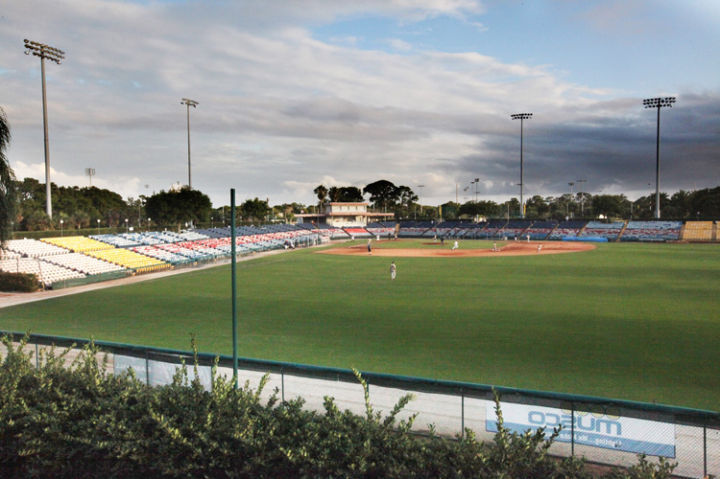
INDIAN RIVER COUNTY — Once officials catch their breath from the frenzied months of negotiations that led to the recent name change from Vero Beach Sports Village to Historic Dodgertown, their next challenge will be to establish a museum to highlight the legendary facility and the men who played ball there.
Vice President Craig Callan, who manages the facility, said he and others involved with the museum concept have been visiting museums far and wide – some sports- themed and some not – to look, learn and dream about ways to display artifacts related to Historic Dodgertown’s colorful life, dating back to 1948.
“We are a member of the Vero Beach Museum of Art and I’ve been there and to the Elliot Museum,” Callan said. “And we’ve got a fantastic relationship with Cooperstown, with the Baseball Hall of Fame.”
From lighting and climate control to sprinkler systems and security, there’s much to be planned and decided. The first phase is to find a spot for and design a building, then to catalog the historical assets already in their possession and determine others to be acquired.
One model they might look to is the success story of another celebrated piece of Vero’s heritage – McKee Botanical Garden. Alma Lee Loy, the matriarch responsible for spearheading efforts to raise more than $10 million to save and enhance the 80-acre garden, was on hand for the unveiling of the new name. Callan said he envisions a similar passionate, grassroots effort to forge the museum into existence.
Callan said he has his eye on Loy and other local philanthropists, envisioning a core group to make the museum come to life. He said barrier island residents could play an important role to infuse both vigor and capital into the project.
“I’m certainly excited about the possibility of the museum project. I just hope that I can be available to help in any capacity,” said Loy. “There’s a segment of the community naturally that is very interested in Dodgertown. I think they are waiting to be rallied to give their support.”
While Callan wouldn’t reveal what treasures are in store for visitors when the museum opens, he assured diehard Dodger fans it’ll be worth the trip.
“There will be no shortage of memorabilia,” Callan said, adding that items from the O’Malley family will be featured in the collection, along with possessions on loan from fans and former players. Part of the rich Dodger heritage includes a cache of old hand-written and typewritten documents and records chronicling the Dodger story.
A recent exhibition of the O’Malley family’s personal collection of Dodger artifacts displayed at the Baseball Hall of Fame in Tokyo offers a glimpse into items that could someday be on exhibit in Vero Beach.
According to a Historic Dodgertown news release, the exhibition in Japan celebrated the 110th anniversary of the 1903 birth of Walter O’Malley, who was inducted into the National Baseball Hall of Fame and Museum in Cooperstown, NY, in 2008.
The 14 items shown in Japan went beyond an impressive collection of autographed baseballs, to include championship rings, Dodger uniforms and a one-of-a-kind, hand-painted Noritake plate signed by 40 players, including 11 Hall of Fame members, and their traveling party during the Dodgers’ 1956 Goodwill Tour to Japan.
Walter O’Malley took control of the Brooklyn Dodgers in 1950, moving them westward in 1958.
His son, Peter O’Malley took the helm in 1970 and led the organization until selling the Los Angeles Dodgers to Rupert Murdoch’s News Corp in 1998.
After a 61-year run of spring training at Vero’s Dodgertown, the Dodgers moved to Arizona in 2009, but Peter O’Malley re-joined the Vero Beach Sports Village team in January 2012 to bring forth a new era, combining a vision for the future while paying homage to Dodgertown’s rich past.
No budget or timeline has been set for the museum but its establishment was one of the benchmark goals laid out in Indian River County’s five-year lease extension signed with then-Vero Beach Sports Village in June.
Indian River County Commissioner Tim Zorc said he looks forward to taking his kids to the museum someday.
“Our family had row two seats behind the Dodger dugout for spring training games and also followed the Dodgers on some road trips to Atlanta,” Zorc said. “I spent a good deal of my childhood out there and I’d like to show my kids what it was like, I remember being out there when the Tokyo Giants played I think in 1968 or 70 – some of those really historic moments in baseball that took place.”
Zorc said he thinks the community and the fans would support the museum because they’re passionate about all things Dodger. Over the years, he’s spotted tourists who detoured from their vacations to pose with the old Dodgertown signs, even in off-season when the place was locked up.
“It’s just something else to put Vero on the map. So many of the major players who played when the Dodgers were here really looked at Vero as home for them,” Zorc said. “There’s just a lot of deep roots here for people who were in the Dodger community, it would resurrect part of that.”
As research and brainstorming lead to proposals, blueprints and eventually bricks and mortar, the scope of the Historic Dodgertown Museum may take on a life of its own.
“The initial idea is that we did not want to go large,” Callan said, adding that a very classy museum of modest magnitude is the goal – for now.”
“When it is done, it will be quality,” Callan said. “Peter (O’Malley) will not do something that is not well thought-out.”



